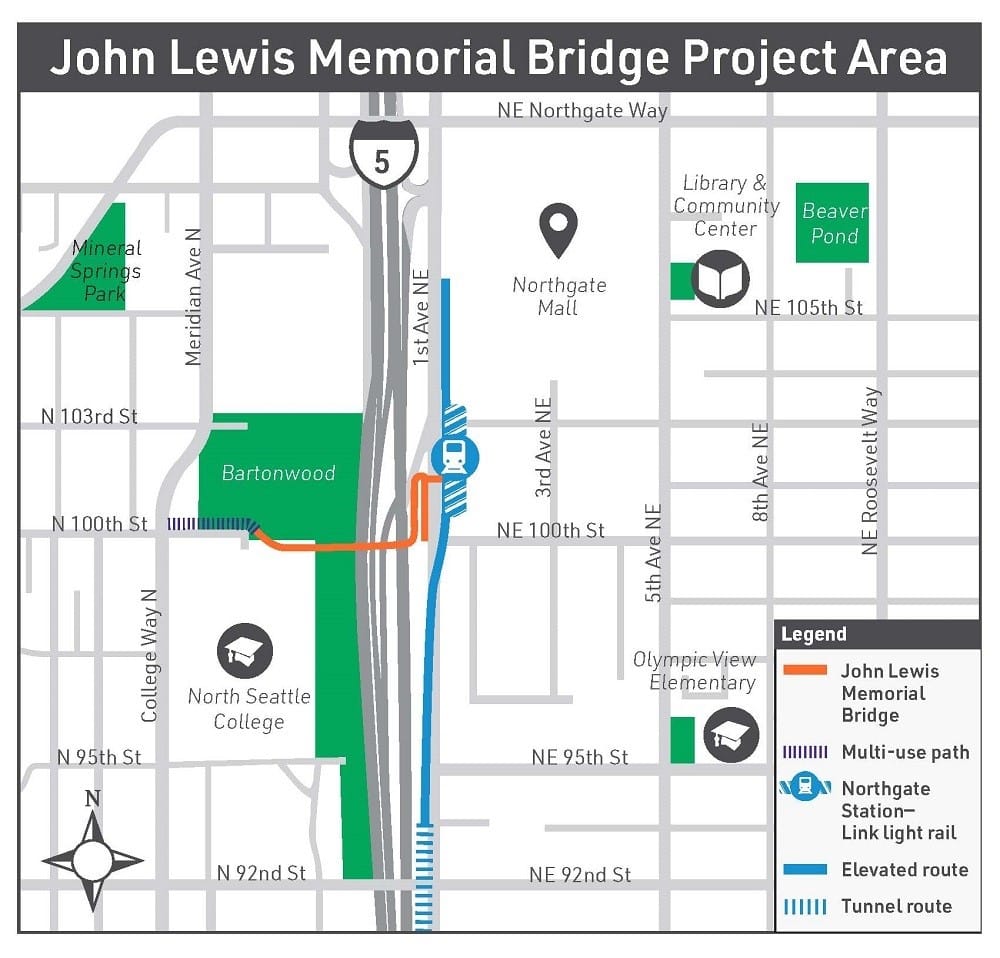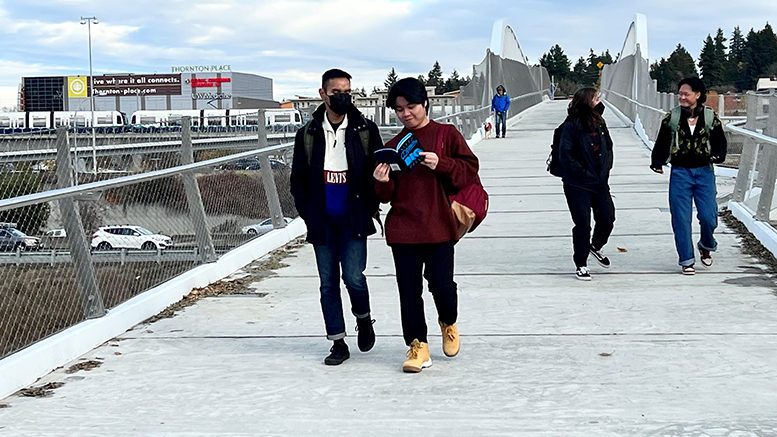When two-year colleges talk about building bridges to their surrounding communities, they are usually speaking figuratively. When leaders at North Seattle College talk about it, however, they’re referring to an actual physical piece of infrastructure, dubbed the John Lewis Memorial Bridge, which opened in October 2021.
The bicycle and pedestrian bridge connects the campus — over a 10-lane portion of Interstate 5 — to the Northgate neighborhood, home to a Sound Transit Link light rail station, a major shopping center and surrounding residential blocks, as well as the citywide network of biking and walking routes. As such, the project has increased access to the campus and, although it’s hard to be exact, likely enrollment as well.
Previously, the journey from the light-rail station to the campus had taken 25 minutes and wasn’t easy to navigate, says Chemene Crawford, president of North Seattle College.
“You had to go underneath the freeway, wind through the neighborhood and poof, there’s the college,” she says. “That was clearly a barrier. We do have a decent bus system running through there. But this project was not just about the college; it was about the community, and also about the fact that Seattle was developing its light-rail system.”
While Crawford believes the bridge has boosted enrollment in North Seattle’s menu of online, hybrid and face-to-face courses, which has stayed steady in the past couple of years, it’s hard to attribute exact numbers.
“But we see the traffic,” she says. “We see people coming and going all the time. I would like to think that our post-Covid rebound, the bridge and light rail station have helped with that. Across the country, colleges have struggled a little bit, and some a-lot-a-bit, during and post-Covid. We have been able to rebound more quickly than expected.”
Location, location, location
While North Seattle College did not set the bridge concept into motion, Crawford says one of her predecessors met with the city to advocate for its current location.

“Originally, the bridge and the light-rail station were going to be farther south,” she says. “Where the college came into play had everything to do with location. Our college leadership was like, ‘Hold on, that [original idea] doesn’t make a lot of sense, given the location of Northgate Mall almost directly across the freeway from the campus.’ I would love to say it’s the college’s idea.”
The transit system’s decision to place the light-rail station at Northgate provided synchronicity because the mall is a major artery for bus lines, Crawford says.
“So you could ride the light rail, get off at the station, walk across the bridge and you’re at work, at school or at home,” she says. “It’s been major. We have employees who take light rail to work and walk across. We see students all day walking across. They used have to wind all the way through the neighborhood. You see them going back and forth across the bridge, whether to shop at the mall, or go see a movie. It has added so much energy to the area. The college is taking the opportunity to reap the benefits of the bridge’s location.”
Naming the bridge
When Crawford became president in 2020, the project was already well in motion, and she sees herself as the “closer” from the college’s point of view, having been involved in issues like the naming of the bridge.
“You see how much it reflects, or could reflect, the whole John Lewis bridge story,” she says, referring to the late congressman and civil rights leader known for leading the “Bloody Sunday” march across the Edmund Pettus Bridge in Selma, Alabama.
“Mind you, it wasn’t a case of discrimination” that access to the campus had been so challenging previously, Crawford says. “But this bridge is about access; it’s about equity; it’s about bringing communities together. That’s why the city council thought this would be a great idea. It has been a win-win for the college. I’m just very pleased to have been the ‘closer’ on it.”
Community input
During the seven-year process from the original proposal to the opening of the bridge, other advocates such as a bicycle group took part in the process, and modifications were incorporated, such as narrowing the width from 20 to 16 feet, shortening the length from 2,100 to 1,900 feet, and altering the sight distance and directness of connections for the staircase on the west entrance, at the North Seattle campus. The west end crosses wetlands on the campus, which required a plan around replacing the trees that needed to be removed, Crawford says.
Among the environmental features incorporated were “carefully designed plantings on the west side of the bridge so that pedestrians on the landing have a clearer view of North Seattle College (NSC), and those on the NSC playing field and in the parking lot can see bridge users approaching,” according to the Seattle Department of Transportation’s summary of the process.
The department’s summary notes that community input was incorporated in several ways, including ensuring safety and security of all bridge travelers, incorporating wayfinding and traffic control into the design, considering the experience of those who bike and use other wheeled devices like scooters and wheelchairs, and connecting the bridge to other infrastructure such as neighborhood bike routes.
Bottom line, Crawford says, is that the bridge has improved access “1000%,” including reducing parking needs.
“Seattle is a community with quite a few bicyclists; we see an uptick in the number of bikes riding to campus,” she says.
Another station on the light rail line is located at one of North Seattle’s feeder high schools. Students there who participate in early college activities take the light rail, go across the bridge and they are at the college, Crawford says.
“They used to have to take a couple of buses or get a ride from their parents. It is night and day as far as connection and accessibility,” she says.

